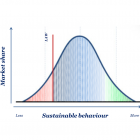Sustainable trade: complex challenges, multiple solutions
Topics
You know the goal: feeding 9 billion people by 2050 with richer diets and increasing energy needs, while staying within the regenerative capacity of one finite planet. You also know the challenges: resource scarcity, deforestation, depleting water resources, extreme poverty, child labour, and land conflicts, all exacerbated by climate change and lack of global governance in an increasingly multipolar world. It will be tough, especially since we’re not even managing now with 7 billion people.

So what to do? In September, the United Nations are expected to adopt the sustainable development goals (SDGs) as the international framework for global development.[ii] It will lead the way for governments AND the private sector in addressing the challenges of global development. I emphasise the private sector, because businesses – more than consumer behaviour – determine and shape our global production systems. Critical citizens are essential for public pressure, but often consumers behave differently from citizens. Changing our production systems in order to sustain 9 billion people on this planet requires a market transformation of epic proportions. No easy answers, no silver bullet solutions.
Distribution curve
If you plot the sustainable behaviour of companies relative to one another, you will get the normal distribution curve: in this case the private sector performance curve. Front runners are on the far right of the curve, with active sustainable behaviour. They are transforming their businesses and entire supply chains. Just right of the middle are the laggards, merely adhering to minimum standards and the law, unaware of possible illegal practises in their supply chains. Further left are companies that do not adhere to international conventions or the law. The ratio between these extremes will vary per sector and most companies are somewhere in between.
Sustainable development is a journey, not a destination. There will always be frontrunners and laggards. In order to achieve the SDGs, we need to move the entire curve to the right. Our strategy to shift the curve is to promote sustainable production and trade. It combines 4 different interventions, aimed at influencing company behaviour at various parts of the curve.
- Firstly, we stimulate innovation for sustainable production, trade and business models. Innovation is the spark that can trigger market transformation. We support the development of new business models that combine social, ecological and economic value through subsidies and public private partnerships. Successful new models will have a pull effect on the middle and left segments of the curve.
- Often, business models that compete on all aspects of sustainability do not yet exist. Still, many companies do recognise the need for a sustainable sector, but are caught in a prisoners’ dilemma: “working on a sustainable business, alone, yields extra costs and will not solve the wider sustainability challenges.” As a second intervention, therefore, we support and facilitate multi-stakeholder platforms. In a pre-competitive domain, companies and civil society set clear sustainability targets and develop a way to get there. We see them reflected in public commitments, voluntary guidelines and covenants. The effectiveness of this approach increases with the market share represented in the platform.
- Thirdly, we endeavour the ending of illegal practises to minimise the dragging tail of the curve. We support local governments to strengthen law enforcement and improve laws and regulations. We build up the capacity of civil society organisations in developing and emerging countries through strategic partnerships for dialogue and dissent, to influence policy development. Our international CSR policy is based on the OECD guidelines for multinational corporations.[iii] They require companies to conduct due diligence on risks of human rights’ violations and illegal practices, and organise mitigating actions. We offer support with practical tools and diplomacy. The Bangladesh Accord of Fire and Building Safety, agreed upon in response to the Rana Plaza building collapse,[iv] shows the powerful change generated when government policies are combined with the commercial weight of companies that want to ‘clean up’ their supply chain.
- To sustain a rightward movement of the curve, we ensure a sound legality bar: our fourth intervention. All countries have their own responsibility in setting minimum standards and implementing international agreements. This can be supported by government support, commercial pressure or requirements from major consumer markets.
Sustainability journey
We’re on a sustainability journey, and we’re getting more traction every day. More and more companies are stepping up the pace with sourcing guidelines to clean up their supply chains from illegal practices and strong sustainability commitments. This journey has primarily been driven by western markets. Increasingly, we will witness companies, civil society organisations and governments in developing countries and emerging markets taking ownership to shape their production systems towards sustainability. Dutch companies are well positioned to build on that trend from pole position. Doing business abroad enables you to bring a positive change.
I am confident we will find ways to overcome the challenges of our age, finding new ways collectively. Find out about your company’s international links and discover opportunities to grow your business for the better. Join the journey!
Sustainable Economic Development Department
Ministry of Foreign Affairs